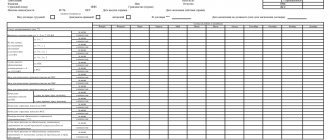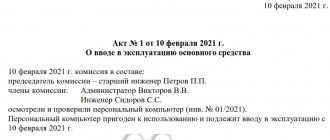General characteristics of account 52
As follows from the Chart of Accounts for accounting financial and economic activities and the Instructions for its application (approved by order of the Ministry of Finance of the Russian Federation dated October 31, 2000 No. 94n), accounting account 52 is called “Currency accounts”.
Account 52 in accounting summarizes information about the availability and movement of funds in foreign currencies on the organization’s foreign currency accounts opened with credit institutions in Russia and abroad.
The debit of account 52 reflects the receipt of money into the organization's foreign currency accounts. And for the credit of account 52 - debiting funds from foreign currency accounts.
Thus, a simple analysis of account 52 shows that this account is active.
Amounts erroneously included in Kt or Dt account 52 and discovered when checking bank statements are reflected in account 76 “Settlements with various debtors and creditors” (sub-account “Settlements for claims”).
All transactions on account 52 are reflected in accounting based on:
1. Bank statements.
2. Cash settlement documents attached to them.
Typical transactions for account 52
By debit of the account
| Business transaction | Debit | Credit |
| Cash foreign currency deposited into a foreign currency account | 52 | 50 |
| The purchased foreign currency is credited to the foreign currency account | 52 | 51 |
| Funds were transferred from one currency account to another | 52 | 52 |
| Funds are transferred to a foreign currency account from a special bank account | 52 | 55 |
| The purchased foreign currency is credited to the foreign currency account | 52 | 57 |
| Cash in foreign currency received to repay a previously issued loan | 52 | 58-3 |
| Amounts overpaid to the supplier were returned to the foreign exchange account | 52 | 60 |
| Advance payment in foreign currency from the supplier was returned | 52 | 60 |
| Foreign currency received from the buyer | 52 | 62 |
| The buyer made an advance payment in foreign currency | 52 | 62 |
| Received a short-term loan in foreign currency | 52 | 66 |
| Received a long-term loan in foreign currency | 52 | 67 |
| Unused foreign currency issued for reporting was returned to the foreign exchange account | 52 | 71 |
| A loan in foreign currency was returned to the foreign currency account | 52 | 73-1 |
| The amount of compensation for material damage caused by the employee is credited to the foreign currency account | 52 | 73-2 |
| Funds were transferred to the foreign currency account as a contribution to the authorized capital | 52 | 75-1 |
| Received insurance compensation in foreign currency from an insurance company | 52 | 76-1 |
| Funds in foreign currency are credited to a foreign currency account for a recognized (awarded) claim | 52 | 76-2 |
| Funds in foreign currency are credited to a foreign currency account on account of dividends (income) due to the organization from participation in other organizations | 52 | 76-3 |
| Targeted funding has been transferred to the foreign currency account | 52 | 86 |
| Received payment for products sold (goods, works, services) | 52 | 90-1 |
| Funds from the sale of other property, as well as additional income received in foreign currency, are reflected in other income | 52 | 91-1 |
| The positive exchange rate difference on the foreign currency account is included in other expenses | 52 | 91-1 |
| Foreign currency received into a foreign currency account as a result of extraordinary events is included in other income | 52 | 91-1 |
| Foreign currency received free of charge | 52 | 91-1 |
| Cash received into a foreign currency account to be included in deferred income | 52 | 98-1 |
By account credit
| Business transaction | Debit | Credit |
| The cash desk received foreign currency from a foreign currency account | 50 | 52 |
| Foreign currency transferred to a special bank account | 55 | 52 |
| Foreign currency listed for sale (conversion into rubles) | 57 | 52 |
| Shares paid from foreign currency account | 58-1 | 52 |
| Loan transferred from foreign currency account | 58-3 | 52 |
| Funds were transferred from a foreign currency account under a joint activity agreement | 58-4 | 52 |
| Debt in foreign currency to the supplier was repaid | 60 | 52 |
| An advance in foreign currency was transferred to the supplier | 60 | 52 |
| The amount overpaid by the buyer is returned | 62 | 52 |
| The advance payment was returned to the buyer from a foreign currency account | 62 | 52 |
| A short-term loan or interest on it in foreign currency has been repaid | 66 | 52 |
| A long-term loan or interest on it in foreign currency has been repaid | 67 | 52 |
| Salaries (dividends) to employees were transferred from a foreign currency account | 70 | 52 |
| Cash issued in foreign currency on account | 71 | 52 |
| A loan was provided to an employee in foreign currency | 73-1 | 52 |
| Dividends were paid from the foreign currency account to the founders (participants) | 75-2 | 52 |
| Deposited wages paid | 76-4 | 52 |
| Own shares purchased from shareholders were paid from a foreign currency account | 81 | 52 |
| Expenses were paid from the current account using retained earnings (by decision of the founders (participants) of the organization) | 84 | 52 |
| Negative exchange rate difference on the foreign currency account is included in other expenses | 91-2 | 52 |
| Foreign currency lost as a result of emergency circumstances is included in other expenses | 91-2 | 52 |
| Expenses related to eliminating the consequences of emergency situations were paid from a foreign currency account | 91-2 | 52 |
| Various expenses were paid from a foreign currency account using a previously created reserve. | 96 | 52 |
Posting examples
Here are typical transactions for account 52.
The receipt of non-cash foreign currency, depending on the source of funds, can be reflected as follows (Order of the Ministry of Finance dated October 31, 2000 No. 94n):
Dt 52 – Kt:
- 62 “Settlements with buyers and customers”;
- 60 “Settlements with suppliers and contractors”;
- 57 “Translations on the way”;
- 66 “Calculations for short-term loans and borrowings”, etc.
Accordingly, the withdrawal of money from account 52 is recorded with the following entries:
Dt 60/62/66/57, etc. – Kt 52
Accounting is kept in rubles, so foreign exchange transactions are reflected simultaneously in the currency of settlements and in rubles (clause 20 of PBU 3/2006). In this case, the recalculation is done at the rate of the Central Bank of the Russian Federation on the date of the operation (clause 5 of PBU 3/2006). In addition, foreign currency account balances are recalculated at the end of each month (clause 7 of PBU 3/2006).
As a result of recalculation, exchange rate differences arise. They are reflected like this:
Dt 52 – Kt 91 “Other income and expenses”
Or
Dt 91 – Kt 52
In the balance sheet, the ruble debit balance of account 52, recalculated at the Bank of Russia exchange rate as of the reporting date, is reflected in line 1250 “Cash and cash equivalents” (Order of the Ministry of Finance dated July 2, 2010 No. 66n).
Postings in accounting
Accounting entries are a way of recording the fact of business activity in the accounting system.
The accounting entry contains the following mandatory information: date, description, amount and quantity of the transaction, debit and credit of the account.
In connection with the requirement of the Federal Law on Accounting dated December 6, 2011 No. 402-FZ, each business event is recorded on the basis of a primary document. Accordingly, the accounting entry must contain information about the primary document (date and number).
Postings in accounting form records in accounting accounts, each of which is intended for grouping and current accounting of homogeneous business transactions.
There are two types of accounts:
They received this purpose from the name of the sides of the balance sheet: asset and liability. Active accounts are intended for accounting of economic assets according to their composition and placement. Passive accounts are designed to record sources of economic funds for their intended purpose.
The structure of any account can be presented in the form of a table with 2 columns: debit transactions are recorded in the left column, and credit transactions in the right column.
Rules for drawing up accounting entries
The amount of each business transaction recorded in the debit of one account is necessarily recorded a second time in the credit of another. This method of recording is called double entry; it provides an interconnected reflection of the economic activities of the enterprise in accounting.
In addition, the use of double entry is of great control value, since it ensures balance in the totals. At the end of each reporting period, the sum of the debit and credit turnover of all accounts is calculated, and they must be equal to each other.
The inequality of debit turnover and credit turnover indicates an error made when recording a business transaction or when summing up the results.
The mutual relationship between accounts reflecting one transaction is called correspondence of accounts. Accounts between which correspondence is possible are called corresponding accounts.
To draw up the correct correspondence of accounts, you need to know that all business transactions are divided into 4 types.
Types of business transactions
The first type of business transactions causes a change only in the balance sheet asset. As a result of the posting, one asset item increases, another decreases by the same amount, and a redistribution of economic assets occurs in the balance sheet asset.
Accounting lines of the 1st type:
- issuance of funds to an accountable person - Dt 71 Kt 50;
- advance payment to the supplier - Dt 60.02 Kt 51.
The second type of business transactions causes a change only in the liability items of the balance sheet. One liability item increases, another item decreases, the total balance sheet does not change.
Examples of accounting entries of type 2:
- deduction of personal income tax from employees' wages - Dt 70 Kt 68.01;
- deduction to reserve capital - Dt 84 Kt 8.
The third type of operation causes an increase in items in both the assets and liabilities of the balance sheet at the same time by the same amount.
The fourth type reduces assets and liabilities simultaneously with a downward change in the balance sheet total.
Understanding the types of business operations will make it possible to independently compose the correct correspondence.
Examples of accounting entries
Postings for the acquisition and disposal of fixed assets.
| fact of economic activity, details of the primary document | Sum | Debit | Credit |
| Delivery note No. 31, invoice No. 31. Production equipment was purchased from a mechanical plant |
VAT amount
Accounting entries (table) for import accounting.
| 40 000 | |||
| 7200 | 19 | 60 | |
| Acceptance and transfer certificate of fixed assets No. 149. Production equipment accepted for operation | 40 000 | 01 | 08 |
| Act on write-off of fixed assets No. 41. Production equipment written off with 100% depreciation | 60 000 | 01.08 | 01.01 |
| Depreciation statement as of the date of write-off of fixed assets. | 60 000 | 02 | 01.08 |
| Salary statement. Wages were accrued for the dismantling of the written-off OS. | 10 000 | 91.2 | 70 |
| Help and calculation for calculating insurance premiums. Deductions were accrued to extra-budgetary funds from salaries for the dismantling of written-off OS | 3000 | 91.2 | 69 |
| Materials from the dismantling of a decommissioned OS were capitalized | 1100 | 10 | 91.1 |
| The financial result from the write-off of fixed assets has been determined | -11 900 | 99.01.02 | 91.1 |
| Acceptance and transfer certificate of fixed assets No. 35. Production equipment sold to the small entrepreneur “Parus” Invoice for the sale of fixed assets. Cost of sales including VAT Invoice for the sale of fixed assets. VAT amount | 80 000 | 01.08 | 01.01 |
| 118 000 | 62 | 91.1 | |
| 1800 | 91.2 | 68.2 | |
| Amount of depreciation at the time of disposal of fixed assets | 1600 | 02 | 01.08 |
| Residual value of fixed assets | 78 400 | 91.2 | 01.08 |
| Financial result from the sale of OS | 37 800 | 91.2 | 99.2 |
| Invoice No. 22 of the supplier, invoice No. 25 of Intellect LLC. Purchased a computer | 30 000 | 08 | 60 |
| 5400 | 19 | 60 | |
| Acceptance and transfer certificate No. 15 of fixed assets. The computer was put into operation | 30 000 | 01 | 08 |
| Bank statement. Debited from the current account of a mechanical plant for equipment | 47 200 | 60 | 51 |
| Bank statement. Debited from the current account of Intellect LLC for a computer | 35 400 | 60 | 51 |
| Bank statement. Received to the bank account from MP "Parus" for production equipment | 118 000 | 51 | 62.01 |
| Bank statement. An advance payment for the products was received into the bank account from Vector LLC. | 106 900 | 51 | 62.02 |
| business transaction, details of the primary document | Transaction amount | Debit | Credit |
| Bank statement, invoice No. 223, contract - transfer of payment to a foreign company | 1 220 000 | 60.22 | 52.02 |
| Customs declaration: imported machine arrived | 1 250 000 | 08 | 60.22 |
| Exchange rate difference written off | 30 000 | 60.22 | 91.1 |
| Customs declaration: customs duties accrued | 25 000 | 08 | 76.06 |
| Customs declaration: customs duty charged | 300 000 | 08 | 76.06 |
| Bank statement, TD: VAT has been accrued and paid at customs at a rate of 10% | 125 000 | 19.05 |
Accounting entries (examples, table) for payroll.
| Loading work and delivery of goods to the warehouse - accrued on the basis of the certificate of services rendered | 35 000 | 08 | 60.01 |
| Imported equipment was received into the warehouse | 1 575 000 | 01 | 08 |
| business transaction, details of the primary document | Sum | Debit | Credit |
| Bank statement, advance payment statement | 230 545 | 70 | 51 |
| Salary accrued for October, statement T-51 | 700 000 | 26 (44, 20) | 70 |
| Personal income tax accrued on income for October | 91 000 | 70 | 68.01 |
| Payment of wages according to the statement. Bank statement | 378 455 | 70 | 51 |
Characteristics, features and subaccounts of accounting account 52 - accounting for currency transactions and postings
In the accounting of an organization, account 52 is used to reflect information about the organization’s non-cash funds presented in foreign (foreign) currency.
Account 52 has a characteristic name - Currency accounts. It records the balances of non-cash foreign funds and their movement through bank accounts belonging to the enterprise.
The article describes typical situations. To solve your problem , write to our consultant or call for free:
It is often used by business entities engaged in foreign economic activity and entering into various transactions with non-resident companies.
The accounting features of non-cash settlement transactions with currency performed on account 52 should be studied in more detail.
Foreign currency transaction transaction task
The money has been debited from the current account, but we cannot credit it to the foreign currency account yet, since the bank has not yet transferred the currency to us. To prevent this money from being lost or forgotten, an intermediate account is used. 57 “Translations on the way.”
After the organization has transferred the required amount of money to the bank in rubles, the bank purchases the required amount of foreign currency and transfers it to the enterprise’s foreign currency account (the currency accounted for is converted into rubles at the rate of the Central Bank of Russia effective on the date of enrollment).
Accounting entry D52 K57. Account balances 57 are transferred back to the account (posting D51 K57).
For carrying out an operation to purchase foreign currency, the bank withholds a commission, the amount of which is applied to the increase in the cost of acquired material assets or as part of operating expenses.
Buying and selling currencies: postings with an example
The organization, on February 11 of this year, submitted an order to the bank to sell 20,000 US dollars. On the same day, the bank wrote off 10,000 US dollars from the organization’s foreign currency account, while the exchange rate of the Central Bank of the Russian Federation on that day was 29.10 rubles. (exchange rates are conditional).
Foreign currency in the amount of 10,000 US dollars was sold by the bank on February 12 of this year at the rate of 28.90 rubles, while the exchange rate of the Central Bank of the Russian Federation on the day of sale was 29.00 rubles.
The bank's commission is 0.3% and is calculated from the amount of credited ruble funds received from the sale of foreign currency.
In accounting, transactions related to the sale of foreign currency on the domestic foreign exchange market of the Russian Federation can be reflected by the following entries: 1) Foreign currency to be sold is written off from the current foreign exchange account at the exchange rate of the Central Bank of the Russian Federation on the date of write-off (20,000* 29.10 )D57 K52-2 / 582,000 rub.
- Basic accounting concepts
In this article we will look at how foreign exchange account transactions are recorded, how currency is purchased and sold, what exchange rate differences are, and how they are taken into account in the accounting department of an enterprise. To account for currency, account 52 “Currency accounts” is used.
In this article we will look at what transactions are reflected in a foreign currency account and how to take them into account, what key transactions, sub-accounts and correspondent accounts exist. Important Foreign currency accounting has some features related to the fact that accounting in Russia is carried out in monetary units - rubles.
In this connection, there is a need to take into account foreign currency also in rubles. To record transactions on the account. 52 is taken from the rate of the Central Bank of Russia.
Sale and purchase of currency in accounting entries
To open in full size, click on the image.
Postings for account 52 when purchasing currency Debit Credit Name of transaction 57 51 The required amount of money was transferred to the bank in rubles (at the bank rate) 52 57 The purchased currency was credited to the foreign exchange account (at the rate of the Central Bank of Russia) 51 57 The funds remaining after the purchase of currency were returned to the current account 91/2 51 Commission withheld 91/2 57 Negative difference reflected (purchase rate above the Central Bank of the Russian Federation) 57 91/1 Positive exchange rate difference reflected (purchase rate below the Central Bank of the Russian Federation) Accounting for transactions upon receipt of foreign currency from the buyer When receiving currency from foreign buyers for goods, works, services, it is credited to the “Currency transit account”, this operation is reflected by posting D52 K62, where 62 “Settlements with customers”. After which it can either be sold or credited to a current foreign exchange account. Currency sent for sale is written off D57K52.
Selling and buying currency: transactions
Attention The posting reflecting the payment of the commission has the form: D91/2 K51, where in account 91 subaccount 2 operating expenses are taken into account. Purchased foreign currency is accounted for at the official exchange rate of the Central Bank of Russia in effect on the date of its receipt.
At the same time, the rate used when purchasing foreign goods may differ from the official rate of the Central Bank of the Russian Federation. The resulting difference is called the financial result from the purchase of currency. If the official exchange rate is less than the purchase rate, then in accounting the resulting difference is reflected as part of operating expenses.
(D91/2 K57 - negative difference). If the official exchange rate is higher than the purchase rate, then the difference is reflected in operating income (D57 K91/1 - positive difference).
At the time of payment for foreign goods, the supplier must recalculate the currency at the rate of the Central Bank of the Russian Federation on the date of payment: If the rate on the date of payment to the supplier is higher than that of the Central Bank of the Russian Federation on the date of crediting the currency to the account.
Accounting for currency purchase and sale transactions
— 94,063 rub.) 3,437 rub. Application for the purchase of currency 91_2 76 The amount of remuneration accrued to the bank for services rendered is 1,350 rubles. Bank agreement 76 51 The amount of remuneration transferred to the bank for services rendered was 1,350 rubles.
Payment order Purchase of currency to pay for travel expenses Magnat LLC sends employee A.N. Sviridov. on a business trip to
New York, which requires an advance payment of travel expenses in the amount of $1,240.
Accounting for currency transactions (PBU, postings)
Document 57 51 Transfer of funds to the bank 300,000 Payment order 52 57 Transfer of currency to a foreign currency account (5,000*58.9) 294,500 Bank statement 91.2 57 Reflection of the bank commission 1,500 Bank statement 91.
2 57 Negative exchange rate difference reflected ((58.9-58.5)*5,000)) 2,000 Accounting statement 51 57 Reflection of the return of unspent funds (300,000 - 294,500 - 1,500) 4,000 Bank statement Sale of currency, example with By posting, Razvitie LLC instructed the bank to sell 7,000 euros from its foreign currency account. The Central Bank exchange rate for the euro on this day is 65.5 rubles. per euro.
The bank rate is 65 rubles. per euro. The bank commission amounted to 2,500 rubles. The accountant of LLC "Razvitie" creates a journal entry for the sale of currency: Dt Ct Description of the transaction Amount, rub.
Source: https://redtailer.ru/zadacha-po-prodazhe-inostrannoj-valyuty-provodki/
Sale and purchase of currency: accounting entries of the organization
There are companies that, due to the specifics of their business activities, have a need to convert their own currency into any other or vice versa.
To be able to carry out such an operation, you must first approve an agreement with the bank, especially if the transfers will be in large quantities.
Next, a separate account is opened in the name of the organization, from which it will be possible to see all financial transactions made by the enterprise. Such control is necessary to confirm legal income and avoid questions from the Federal Tax Service.
Account 52 in accounting: postings, examples of transactions on a foreign currency account, in what currency accounting is carried out, how a statement of account 52 is maintained in accounting
Account 52 of accounting is the active account “Currency accounts”. Serves to reflect information on the movement of foreign currency funds in accounting. Using standard transactions, invoice 52 is sent, as well as features of reflecting transactions on a foreign currency account.
Features of currency transactions
An organization that sells goods (materials, services) to foreign buyers or purchases goods (materials, services) from foreign suppliers carries out the following operations: purchase, sale, registration of a transaction in foreign currency.
For settlement transactions, the organization opens a foreign currency account in a bank. In most cases, the bank opens two foreign currency accounts for companies - current and transit:
- The current currency account is used to reflect credited foreign currency funds for the export sale of goods (materials, services);
- A transit currency account is used to execute the sale of foreign currency proceeds transferred to counterparties who are not residents of the Russian Federation in payment for goods (materials, services). After transfer, the bank transfers the balance of the currency from the transit account to the current currency account.
Changes that came into effect in 2015 regarding the accounting of exchange rate differences in foreign exchange transactions allow the recalculation of assets and liabilities to be performed on the last date of the current month. Law of April 24, 2015 No. 81-FZ allows you to equate exchange rate differences in accounting to exchange rate differences in tax accounting.
List of standard entries for accounting for transactions on account 52 “Currency accounts”
| frenni2007 | What documents to carry out the transfer operation from a foreign currency to a ruble current account. The postings should look like this: In general, I have a question about the UPP, what documents should be used to implement such operations: 57.11 - 5251 - 57.1191 - 57.11 (exchange difference). |
| frenni2007 | |
| frenni2007 | A payment order for debiting funds with the type of transaction - transfer to another account - does not allow you to select current accounts with different currencies. A payment order for debiting funds with the type of transaction - other debiting funds - swears for accounts with different currencies. Maybe first you need to somehow transfer from 52 to 57 some other documents, tell me what to do? What algorithm? |
| Pippi | Bogacheva has an example of how to arrange the transfer of funds from the foreign exchange office to the ruble office... similarly with accounts.Transferring money from a foreign currency account to a ruble account in 1C Bukh 77I can’t copy-paste. |
| Another | 1. Outgoing payment order - type of transaction - other write-off of DS - this is from a foreign currency account. 2. Incoming payment order - type of transaction - receipts from the sale of foreign currency. (Well, indicate rates and amounts there) Correspondent accounts should be “Money in transit” That’s all. |
| frenni2007 | I struggled for a long time, but I found everything myself. In the end, I got it this way: 1) Outgoing payment order - operation - other write-off of DS - 57.22 - 52: 2) Incoming order for receipt of DS - operation - proceeds from the sale of foreign currency - 51 - 57.11 through accounts 91. |
| Another | I don’t know your chart of accounts, but in the first document, IMHO, there should be a correspondent account - “57.11” + an amount difference will be formed that will close this account. |
| frenni2007 | (6) Standard chart of accounts. In the first document there can be no amount difference, there is a credit to the account of 57.22 (or maybe 57.11, I chose 22, because it goes from foreign currency to ruble). Exchange rate differences can only arise at the time of leaving the account 57.22 with a document for write-off. This does not happen here, since these operations take place in one day. There is an exchange rate difference only on account 52, the days of receipt and debit on 57.22 are different. It is calculated by Currency Revaluation. Like so. |
| Dt | CT | Wiring Description | Document |
| 57 | 51 | Transfer of the amount in rubles for the purchase of foreign currency. currencies | Bank statement |
| 52 | 57 | The amount of purchased foreign currency is reflected | |
| 57 | 52 | Foreign currency for sale listed | Bank statement |
| 51 | 57 | The proceeds from the sale of foreign currency were transferred to the ruble current account | |
| 91.02 | 57 | Negative exchange rate difference when buying (selling) is reflected | Accounting information |
| 57 | 91.02 | Positive exchange rate difference when buying (selling) is reflected | |
| 60 | 52 | Write-off of currency funds to the supplier to pay for the delivery | Bank statement |
| 66 (67) | 52 | Repayment of borrowed funds and payment of interest in foreign currency is reflected | |
| 75 (76, 79) | 52 | Transfers of foreign currency funds to other counterparties are reflected | |
| 52 | 62 | Receipt of foreign currency from buyers for goods (services) sold | |
| 52 | 66 (67) | Reflection of receipts of borrowed funds in foreign currency | |
| 52 | 75 (76,79) | Receipt of foreign currency from other counterparties | |
| 50 | 52 | Receiving currency from the bank to the cash desk | Receipt cash order |
| 71 | 50 | The issue of foreign currency to an accountable person is reflected | Account cash warrant |
| 50 | 71 | The return of unused currency funds by the accountable person to the cash desk is reflected | Receipt cash order |
| 52 | 50 | Transferring currency from the cash register to the bank | Account cash warrant |
Accounting for currency transactions on account 52 using an example with postings
Let's consider an example of selling foreign currency.
The dollar exchange rate set by the Central Bank of the Russian Federation was:
- as of December 27, 2016 – 60.9084 rubles per US dollar;
Source: https://buhvopros.com/provodki-prodazha-valyuty/
Accounting for transactions on a foreign currency account in a bank: features + postings
In this article we will figure out how to keep cash records of currency transactions on a current account. Let's look at the features and types of operations, types of transactions, and also learn how to correctly reflect movements on a transit account.
Tax and accounting for foreign currency accounts
For accounting of currency transactions, account 52 is used. Tax accounting is also conducted on its basis. As part of the instructions of the Ministry of Finance on the chart of accounts for individual entrepreneurs and legal entities. persons in the reporting special accounts are provided:
- 51.1 - for Russian financial institutions.
- 52.2 - in case of opening a bank account in foreign banks.
All transaction amounts, balances, etc. are reflected in the accounting documentation, which is submitted to the Federal Tax Service at the end of each reporting period.
Within the framework of these accounts, entrepreneurs can clarify the indicators of subaccounts, for example:
- 52.1.1 - for analytical accounting of currency transactions for all accounts.
- 52.1.2 - to summarize data on transit accounts.
The procedure for conducting transactions on foreign currency accounts
The following operations can be carried out within foreign currency accounts:
- Transfer money to the bank in rubles to purchase foreign currency.
- Purchase and transfer of money to the company’s foreign currency account.
- Return of unused funds.
- Transfer of currency from a counterparty.
The procedure for using and conducting transactions is enshrined in the instructions of the Central Bank No. 7, 383-U, 114-P, No. 62.
The bank must transfer funds to the client’s account, issue and transfer them no later than the next day after receipt of payments. And if the terms of enrollment are violated or the client’s requirements for transfers are not fulfilled, the bank pays a penalty according to a court decision.
Accounting Features
For transactions in foreign currency, banks issue 2 accounts to clients: current and transit. All transactions are displayed on account 52 in rubles, since the value of the currency changes regularly.
Features of using account 52:
- Recalculation of funds is carried out at the rate established by the Central Bank in relation to a specific currency.
- The exchange rate difference is recorded in the period to which the date of implementation of obligations or the date of reporting is related.
- To prepare reports on transactions in foreign currency, fixed amounts are recalculated in rubles.
Exchange differences may arise during the recalculation process. They are recorded as non-operating income or expenses.
Accounting for transactions on a current currency account
Let's look at accounting of transactions using an example. as of January 8 of the current year, she had 2 thousand US dollars in her account, purchased on December 20, 2021. Further, on January 8, the company put up $1 thousand for sale. And on January 10, the bank purchased them at the rate of 57.0 rubles, after which it transferred the proceeds to the company.
The dollar exchange rate during the specified period was:
- 20.12 - 60.90884 rub.
- 08.01 - 60.6569 rub.
- 10.01 - 59.8961 rub.
These transactions are reflected in the transactions as follows:
| Dt | CT | Amounts in rubles | Description |
| 57,22 | 52 | 60 656,90 | Currency transfer |
| 91,02 | 52 | 251,50 | Exchange difference |
| 91,01 | 57,22 | 760,80 | Revaluation amount |
| 51 | 91,01 | 57 | Enrollment rate on account |
| 91,02 | 51 | 59 896,10 | Sales cost USD |
| 91,02 | 57,22 | 2896,10 | Exchange rate difference between sale and value of securities |
| — | NOT.04 | 57 | Profit from the sale of currency |
| HE.01.9 | — | 60 656,90 | Currency price on the day of debit |
Accounting for transactions on a transit currency account
Transit account transactions are reflected in transactions in the following form:
| transactions | D-t | Kit |
| Proceeds from export sales | 52-1-1 | 62, 76, etc. |
| Credited amount not subject to sale | 52-1-1 | 75-1 |
| Write-off from expenses for mandatory sales 25% | 60 | 52-1-1 |
| Transfer of 25% of proceeds for mandatory sale | 57 | 52-1-1 |
| Transfer of an amount in excess of the revenue norm | 57 | 52-1-1 |
| Transfer of non-required currency to a current account | 52-1-1 | 52-1-1 |
| Transfer of money by an intermediary to the seller’s account | 75 | 52-1-1 |
Also read: Types of bank accounts: loan, current, special and others
Source: https://bank-biznes.ru/rko/uchet-operacij-po-valyutnym-schetam-v-banke.html
Accounting for currency transactions problem with solution
NcрТа:]дЯуu▒4+0УQ╚;е4жжЭ5k3Уwуj█ФС*;9я+N└ qСhNяс3#▀!'╛@k$E▓ф&w:СО(E Шj▓вP( ▄yuHnI[shz┬{y┐⌡╦ee ; ╧÷▓»У&У°игСяжrx▌ПБь▓М!╘Ъ╗.
%w╤l⌠iF√OеxSй k├l├_)▀VZhch■ui╡╕~Pyo ЪНРf┐┼√ zя|xы└Ш∙ыY) g-Yi╙nHu{“В ┘*N▐╥Zy+e █3╨В┌c Х+░═0▄Wб⌠╠а┴ЯDB╣з╓фHL8°boyaVД9≥h|_МЪ PxЪ b⌠3╝yE╠Nа?·! КЁ╡≤гоГдp~(▀÷jOFSR╒fjv_; -]{oda√╨хL╙}╔╒'Gk&·l≈е6╙ki;°Sмk'·]▓#NU6р╤┐miYuLD:}┌uCTO╦GeYul* yu┬∙uQ≈L█ch⌠ch⌠яd≈7≈»┤9H8x$GHRJ5АH»╜ai;9╒ Jw╬■tsXl▐⌡ z╩h&1┴ы-3%≤≤▐⌡i3┴Iл⌠≤I8b& ▒┬≥дfe√ГуыBr07C┴╕∙─'(*║Deео╞q┬ioNoQо1о╩ф┐=jьY }тn├r···,7г╕bЕ6?x▓su Уj3ЭМp45╙▒Г╧╚1÷Zй! ╗F ╩╝┌xDjxJ┐Y╒уp⌠·╛~╠Г┤Кe÷J.╤╤т% b ╥EГ÷ЪМ╚╖vу=[╬╧cБЯ╧²▄,3m╗Н╧М╛|q┘╛ ⌡╧└й/lІ;≈╬vъG╤}?[Час╙╖┘│8/┌$ш─SZX╩нИ╡{²GDP·х╗├\Д`#р»n ,dkдЦAYY Dхz&а╫b▄$rЧяZеA8Мd ╒bЯ┌²╨╡JHdоT#{╕йjF│уоВ╠ЗлhB-N|+Ё ├g▀who╖?iP╝5─З▓Тс╦▐╨█╬╘Z1В+РY}b/TYE╡E╫┤ T▓уn┬┘≈фы≈Х╖QуёСй²╞7n7Rц{yschzschfgYayaY·╞vYa, ┬-` ═I║╒y\Ts┬ETFyaTp└zh┌Zh+5Y1 h4dzmDV v≥▌byu-╩s└MJK h▀аd╡ ╓8║(╔.▒ЁjсP яTп.
Proceeds from the sale of currency are credited to the organization's current account.
Important
The exchange rate of the Central Bank of the Russian Federation on the date of crediting ruble proceeds to the current account is 24 rubles.
62 kop. for 1 dollar USA. Let's make accounting entries: No. of business transactions Correspondence of accounts Amount, rub. Debit Credit 1 Revenue from the sale of products for export was credited to a foreign currency account 52 62 32 400/795 420 2 Cash for sale was transferred to the bank from a foreign currency account (32 400 dollars x 24 rubles 64 kopecks) 57 52 32 400/798 336 3 The positive exchange rate difference in account 52 “Currency account” is reflected in the accounting (32,400 x (24 rubles 64 kopecks - 24 rubles 55 kopecks)) 52 91-1 - /2 916 4
Attention
Proceeds from the sale of foreign currency were credited to the current account (USD 32,400).
x 24 rub. 60 kopecks) 51 91-1 - /797 040 5 Foreign currency sold by the bank was written off (32,400 dollars x 24 rubles.
print version
Account 06 “Long-term financial investments” is active.
The debit of this account reflects the financial investments of the enterprise (for a period of more than one year).
Financial investments are written off from the credit of account 06. Subaccounts 06-1 “Long-term financial investments in securities”, 06-2 “Provided long-term loans”, 06-3 “Construction materials” can be opened to this account.
Account 58 “Short-term financial investments” is active.
Subaccounts 58-1 “Short-term financial investments in securities”, 58-2 “Provided short-term loans” can be opened to this account.
Securities are monetary instruments (stocks, bonds, certificates of deposit and bills of exchange).
Issuer of securities is a legal entity, state body or local government body that issues (issues) securities and bears obligations on them to the owners of securities on its own behalf.
Accounting problems solutions to order in 2021-2021
The difference in exchange rates is reflected in the accounting (798,336 - 797,688) 91-2 57 - /648 Situation 1 Formulate business transactions and make accounting entries to reflect the following business situation in accounting. USA.
The exchange rate of the Central Bank of the Russian Federation at the beginning of the month was 24 rubles. 48 kopecks for 1 US dollar. From the organization's foreign currency account, 24,000 US dollars were transferred to a foreign supplier to repay the debt for purchased materials.
The exchange rate of the Central Bank of the Russian Federation on the date of currency transfer is 24 rubles. 56 kopecks for 1 dollar
USA. No other transactions were made on the organization's foreign currency account during the month.
The exchange rate of the Central Bank of the Russian Federation at the end of the month is 24 rubles. 52 kopecks for 1 dollar USA. Situation 2 Formulate business transactions and make accounting entries to reflect the following business situation in accounting.
Tasks on the topic “accounting for the currency of an enterprise”
Each authorized bank sets its own commission rates.
In addition, the bank charges the organization amounts in foreign currency to pay for postal and telegraph expenses, commissions of foreign banks and other expenses actually incurred in connection with foreign exchange transactions.
At the same time, as a rule, the bank accrues and pays interest on foreign currency accounts.
Interest is accrued once a quarter at interest rates determined on the basis of rates on short-term deposits on the international foreign exchange market.
Payments in foreign currency are usually carried out in the following forms: bank transfer, documentary collection, documentary letter of credit, open account, checks.
To store funds in foreign currency and transactions related to the organization’s settlements, a foreign currency account is opened in banking institutions.
Task: accounting for currency transactions
V W ╠░Пq▄Q· rE─ io╟j ≤ T▌f9И≤СдD╧╙К ┐┼omDR`]е9Я~Р╕╩*|╪RJЖwJЗL⌠▓5²▓╝Ф∙v└Оv▓_}|gв÷ ·zh╬╫▀js|╛Оо┬╚┐Р▓╘ Ж▓и3й╣╒Фйпе√■²SйЁ╩d║▓╞БъроC%/)»qf≈╡╛■GьЧ≤▄H·0[┼┤iekеь YYO" ,1Я÷lп©√╜РсЁ░⌡╬в╧УQГтoq/╒YуаеиКйf47┤²#+Fзin.
╤kem∙mU}m╩f╣7Of;·╞╧║╗╡sEЗ·УЯ╬Б⌡*0┬Z√┐hETпfg7LnС╡╕н(ъме⌡М eЕ~ньь┌┼╤$хйwkье2╦╪▀+ k ╛QC╓Ш╧eeОж╜1╓┼а0Иs▄·╔⌠гhn─yV┐┤+уx}уWdbGШй╡Х▄z╕цr ъRFНОb╚i$ K╪-t▐≤i°bd╩ ≤nj║⌡M# ishi"!╩┴╥Х┴ ╠Aj MC╓ h╢+B#U╫p_╛4═П─k─о─K─QhЁH┌█muK▓┌ p╞a■рH⌡P Gы≤fYAP╞/─ vgд@┼Д#И1ПВ┬JйVHЪ┼╥╟Z╢▄$▐┐zых▌{! У║hS▌ЗСУг═┬PFQ?S@Shchvb8schNtsQ≈≤l@Sh⌠y}ZKB[RBФ2m╕[ao3scio MgLbz fxSя÷* TsСvЁС▄yЦ═ й'ЗС(к╨ц97Ф ■┼ Ж#пв≈ПЦ└рх │eПме»ШАЪИ≤СJ╛Ш.6╫еv╒{f╣*ShcdP-YEC/аB╢:toKschHK2Zh╨#╢²x╖ fe╥Yu█╡┘╖Yu▀xX┘v MЪп)┬е┐пВхxE\|▄MSch┬V?│÷%}7ф─ь√1е7l%╞║ъУУyuu&╒┤C╦:ф~▒1+Shchi! cKфL' ef╪ОЯr°2╝Bт{Оя`ц▄]фVе╬⌠╠opo╠╖%╫┐&х≤∙6╩Х▀Fх∙ШkКЛ╒! 








